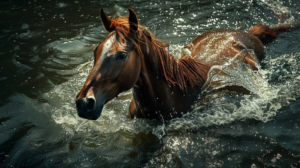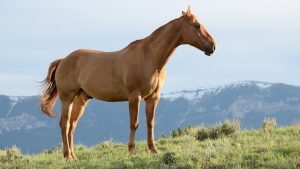Throughout history, the bond between horses and humans has been extraordinary. Horses have served as companions and played crucial roles in transportation, agriculture, and even warfare. Yet, behind every healthy and well-cared-for horse stands a dedicated veterinarian, often unsung heroes who work tirelessly to ensure these majestic creatures thrive. This timeless bond between horses and their veterinary heroes is a testament to the deep connection and mutual respect shared between humans and animals.
I’ve realized that the true backbone of the equestrian world isn’t just the riders or trainers but the veterinarians who keep these magnificent animals in peak condition. Knowing that a skilled professional is there to tend to a horse’s every need, from routine check-ups to emergency care, is profoundly reassuring for those who have the privilege of owning a horse. I can say that the care and dedication of equine veterinarians often make the difference between a horse’s thriving and merely surviving. Their roles are complex and crucial, and their contributions are often understated.
Based on the Market Research Statistics of U.S. Veterinarians in 2018, as posted in the American Veterinary Medical Association, there are about 120,652 positions held for this profession in private, government, and corporate agencies, of which only 4,125 specialize in equine veterinary. In the 2018 study of The American Horse Council Economic Impact, it was estimated that as of 2017, there were 7.2 million horses in the United States. This statistical record shows a need for more horse vets near me, the whole of the U.S.A., and even the whole world, for that matter, to balance the need for equine vets over a huge horse population.
WHY EQUINE VETERINARY?

Equine Veterinary is a profession that aids in preventing, maintaining, and curing equine diseases such as equine herpes virus, Potomac horse fever, equine influenza, streptococcus equi, and tetanus, among others. Equine Veterinarians, our Horse’s Doctors, are the experts who know best for our horse’s overall health and condition. Have you ever asked yourself why you should consider being an equine veterinarian? If you have that compassionate love for horses and want to take action to promote their welfare, then this might just be the profession that will make you happy and fulfilled more than giving you good fortune. The Bureau of Labor Statistics survey conducted in 2017 found that the median wage for veterinarians is around $90,000 per annum. Payscale.com says an equine vet’s average professional income is $64,000 annually.
Equine Veterinary is a profession that aids in preventing, maintaining, and curing equine diseases such as equine herpes virus, Potomac horse fever, equine influenza, streptococcus equi, and tetanus, among others. Equine Veterinarians, our Horse’s Doctors, are the experts who know best for our horse’s overall health and condition.
It is designed so that veterinary school takes up to four years of study and leads to a Doctor of Veterinary Medicine degree. What most success stories of equine veterinarians portray in their stories is the presence of humane acts of care and affection towards horses, especially with the growing instances of animal cruelty in society. They are driven by the willpower to respect the life these animals have as sacred and that it deserves the care necessary as to what human life has.
Inspiring Breakthroughs in Equine Veterinary History
As the pre-Socratic Greek philosopher Heraclitus said, “Change is the only constant in life.” Hence, from the time of our great ancestors, many developments in all aspects of our society have occurred. With equine veterinary medicine, the discovery of horse diseases, the inventions of equine foods, supplements, and medicines, and the development of wellness approaches relating to horses can be credited to the forefathers of this profession who have dedicated their lives to studying and working for the welfare of our horses. The future is yet to unfold for future discoveries along with more changes and developments that will come for our next generation of horse vet near me and the world, and so here are some inspirations we can look up to and be thankful for their contributions in the welfare of our horses;
Carlo Ruini, 1598
He is often known as the father of equine anatomy. His comprehensive treatise on the anatomy and diseases of the horse and the treatment is the foundation of modern veterinary medicine. His book Dell’anotomia et dell’infirmita del Cavallo contains high-quality illustrations attributed to Leonardo da Vinci’s works, and this was the first book dedicated exclusively to studying a single species other than a man.
Andrew Snape, 1683
He wrote one of the first English books in equine anatomy, Anatomy of a Horse.
Claude Bourgelat, 1762
Claude Bourgelat was a French Veterinarian who founded the first Veterinary School in Lyon in 1762. He devoted his time to developing a cure for the disease that caused the cattle plague incident that affected almost all domesticated animals at that time.
Henry Bergh, 1800
Because Bergh only too frequently witnessed a harness horse being abused and being too exhausted to work, he founded the American Association for Prevention of Cruelty to Animals (ASPCA). His efforts led to the passing the first law to protect animals in New York State. The ASPCA maintained shelters for the care and rehabilitation of horses and provided an ambulance to transport injured horses to their treatment facility. In 1912, their first clinic opened, and they pioneered the use of anesthesia and radium in surgical procedures to treat injured animals. Because of Henry Bergh’s call to action against cruelties to horses that he witnessed, there are already around 750 ASPCA groups throughout the country dedicated to caring for and protecting all animals. Through this milestone in the history of the veterinary world, more laws are developed and applied for animal welfare.
Dr. J. Fred Smithcors, 1957
A professor of anatomy at the MSU College of Veterinary Medicine and a Veterinary Historian was the person who acquired the MSU’s Beaudette Collection in 1957, which originally included over 250 rare books and manuscripts and has grown to more than 1,500 items. It is said to be one of the largest and most distinguished collections of artifacts related to the history of veterinary medicine.
Dr. Jacques Jenny
He is a Swiss orthopedic surgeon who developed the famous “pool recovery system” to address the panicking of horses after surgery brought about by the effects of anesthesia. In this process, wrote Jane Simone in her Advances in Equine Veterinary Medicine, 2019, “Horses are awoken from anesthesia in a specially designed and constructed rubber raft in a large, heated pool that allows them to kick freely without risk of injury. Once fully awake, the patient is lifted from the raft and pool secure in a sling and allowed to stand up calmly, or is transported by monorail to the Widener Hospital’s Intensive Care Unit to the safety of a well-bedded stall”
What is it Like to Be an Equine Veterinarian?
Recent interviews with successful equine veterinarians determined how fulfilling their lives are in their chosen profession. It may have taken them years and a huge amount of investment to master this course and get their license to practice this expertise, but what seems to surface as the most important fulfillment they gain is not the fee they earn but the quality of life horses under their care have and that to see how happy their clients are for such a great care given to their horses.
Dr. Phyllis Lose, for instance, is the first woman equine veterinarian who has been featured in many journals of veterinary success, including The Reader’s Digest and was said to have helped numerous horses at the time of her practice. She had also built hospitals for horses and had influenced many other practitioners to have that sense of passion to care for horses as she does. Her story has inspired many, as she was the youngest licensed equine trainer at age 19.
Most equine veterinarians are in private practice, where they may own solo practice or partner with some staff, fellow veterinarians, or a referral on hospital set-up. Others focus their expertise on breeds or disciplines that greatly interest them, such as racehorses or Western pleasure horses.
Many private veterinarians are ambulatory practitioners who enjoy traveling to their clients to perform their services. You may find that their vehicle is an office on wheels as they always have with them often a full stock of equipment and medication necessary to perform their expertise addressing horse concerns on site.
When Do You Need To Call Your Equine Veterinarian?
Like humans, who need regular check-ups and health maintenance to ensure the body’s wellness and maintain quality performance in daily life, animals, particularly horses, especially those joining regular race events and ranch work, also need these kinds of health care. Aside from a regular check-up schedule, the need to call your equine or horse vet is a must when any of the instances arise concerning your horse:
- If your horse encounters any injury with profuse bleeding, that won’t stop. This
instance cannot be delayed as it may place your horse in a life-and-death
situation for losing too much blood. - If you notice or suspect a fracture, as you may see on the physical appearance of
your horse’s body. Do not wait until it swells and it gets even more serious. - If an injury or cut on your horse’s skin needs suturing and
stitches. Do not attempt to do it alone, as you may infect your horse
without the proper sterile techniques. - If you suddenly notice a change in your horse’s behavior, lameness appears, and
you have no idea why. - If you notice an abnormality or sudden difference in your horse’s breathing
pattern, which often noisy labored breathing. - If your horse is choking. Food particles and saliva may often go out on nostrils
and you can see a neck stretched out. - Seizure episodes brought about by unknown reasons.
- If your horse is experiencing watery diarrhea. Do not waste time; an immediate
response must be given as this condition may lead your horse to dehydration. - If you see an obvious injury or abnormality in your horse’s eyes. Lack of
treatment or incorrect treatment could mean a loss of vision. - Learn to recognize the signs of pain manifested in your horse’s behavior. If you
notice a change in his normal behavior and could not understand why your horse
is acting differently, It is best to consult your physician at once to avoid
further injury.
You must be aware and familiar with the normal characteristics of a healthy horse to distinguish what abnormalities occur and know when to call your equine vet. The horse also has a normal range of value in what we call vital signs as we humans have, and these are as follows;
- The body temperature of a horse ranges from 37.4-38.4ºC.
units below or above this range may indicate something, and you must consult
your veterinarian about it for further instructions on what you could do - The Horse’s RHR or Resting Heart Rate range at 36-42
beats per minute (bpm). The horse’s pulse rate normally returns
to normal after regular exercise. Measuring this vital sign can be done using your three fingers in the middle and locating your horse’s pulse area, usually found beneath the chestnut in the front legs, inside edge of the
lower jaw, etc. Place your fingers on the pulse area and count the pulse
felt within one minute. - The horse’s respiration rate (RR) ranges from 8 to 14 breaths per minute, which is visible with the rising of the horse’s ribcage as it inhales and exhales. This can also be determined with the
movement of the curve of the flank or nostrils. - The horse must have a normal gut sound rhythm. The absence of or overly noisy gut sounds indicates gastrointestinal tract diseases such as colic or diarrhea.
- Hydration Test using the skin turgor test must result in a return of 1 second. Remained elevated skin after the test indicates dehydration and is often accompanied by coldness and fatigue, muscular tremors, colic, thumps, unresponsiveness, lack of appetite, and low pulse: respiration ratio.
- The Capillary response Time (CRT) must be 1 to 2 seconds. This is done by applying finger pressure for about 3 to 4 seconds on the gum of the upper lip, leaving a white mark, and upon release, the
natural color of pink must return in 1 to 2 seconds to say it’s normal. - Check that the mucous membranes of your horse are a rich pink; paleness indicates a problem or the presence of a disease.
Veterinarians are the heroes behind the scenes, ensuring that horses live healthy, happy lives. Their unwavering dedication, extensive knowledge, and compassionate care are the bedrock upon which the equine world stands. As we admire the grace and power of horses, let us also remember and honor the veterinarians who work tirelessly to maintain their well-being.





